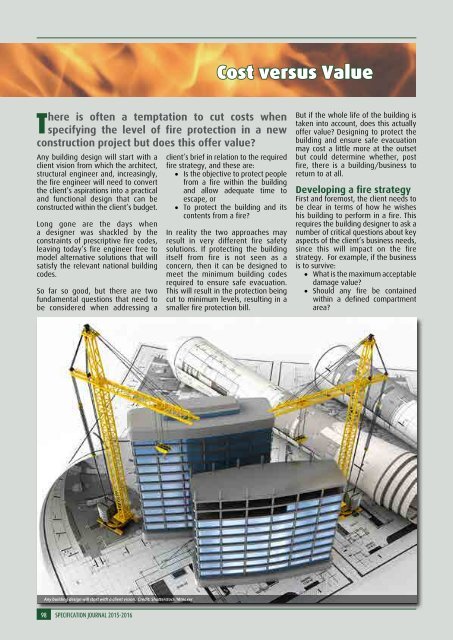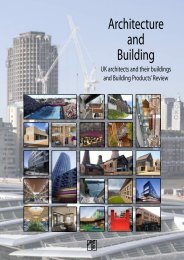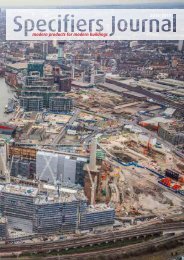Specifiers Journal 2015-2016
Specifiers Journal 2015-2016
Specifiers Journal 2015-2016
Create successful ePaper yourself
Turn your PDF publications into a flip-book with our unique Google optimized e-Paper software.
Cost versus Value<br />
There is often a temptation to cut costs when<br />
specifying the level of fire protection in a new<br />
construction project but does this offer value?<br />
Any building design will start with a<br />
client vision from which the architect,<br />
structural engineer and, increasingly,<br />
the fire engineer will need to convert<br />
the client’s aspirations into a practical<br />
and functional design that can be<br />
constructed within the client’s budget.<br />
Long gone are the days when<br />
a designer was shackled by the<br />
constraints of prescriptive fire codes,<br />
leaving today’s fire engineer free to<br />
model alternative solutions that will<br />
satisfy the relevant national building<br />
codes.<br />
So far so good, but there are two<br />
fundamental questions that need to<br />
be considered when addressing a<br />
client’s brief in relation to the required<br />
fire strategy, and these are:<br />
• Is the objective to protect people<br />
from a fire within the building<br />
and allow adequate time to<br />
escape, or<br />
• To protect the building and its<br />
contents from a fire?<br />
In reality the two approaches may<br />
result in very different fire safety<br />
solutions. If protecting the building<br />
itself from fire is not seen as a<br />
concern, then it can be designed to<br />
meet the minimum building codes<br />
required to ensure safe evacuation.<br />
This will result in the protection being<br />
cut to minimum levels, resulting in a<br />
smaller fire protection bill.<br />
But if the whole life of the building is<br />
taken into account, does this actually<br />
offer value? Designing to protect the<br />
building and ensure safe evacuation<br />
may cost a little more at the outset<br />
but could determine whether, post<br />
fire, there is a building/business to<br />
return to at all.<br />
Developing a fire strategy<br />
First and foremost, the client needs to<br />
be clear in terms of how he wishes<br />
his building to perform in a fire. This<br />
requires the building designer to ask a<br />
number of critical questions about key<br />
aspects of the client’s business needs,<br />
since this will impact on the fire<br />
strategy. For example, if the business<br />
is to survive:<br />
• What is the maximum acceptable<br />
damage value?<br />
• Should any fire be contained<br />
within a defined compartment<br />
area?<br />
Any building design will start with a client vision. Credit: Shutterstock/Mmaxer<br />
98 SPECIFICATION JOURNAL <strong>2015</strong>-<strong>2016</strong>








